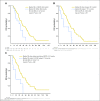Clinical and Genomic Characterization of Treatment-Emergent Small-Cell Neuroendocrine Prostate Cancer: A Multi-institutional Prospective Study
- PMID: 29985747
- PMCID: PMC6366813
- DOI: 10.1200/JCO.2017.77.6880
Clinical and Genomic Characterization of Treatment-Emergent Small-Cell Neuroendocrine Prostate Cancer: A Multi-institutional Prospective Study
Abstract
Purpose The prevalence and features of treatment-emergent small-cell neuroendocrine prostate cancer (t-SCNC) are not well characterized in the era of modern androgen receptor (AR)-targeting therapy. We sought to characterize the clinical and genomic features of t-SCNC in a multi-institutional prospective study. Methods Patients with progressive, metastatic castration-resistant prostate cancer (mCRPC) underwent metastatic tumor biopsy and were followed for survival. Metastatic biopsy specimens underwent independent, blinded pathology review along with RNA/DNA sequencing. Results A total of 202 consecutive patients were enrolled. One hundred forty-eight (73%) had prior disease progression on abiraterone and/or enzalutamide. The biopsy evaluable rate was 79%. The overall incidence of t-SCNC detection was 17%. AR amplification and protein expression were present in 67% and 75%, respectively, of t-SCNC biopsy specimens. t-SCNC was detected at similar proportions in bone, node, and visceral organ biopsy specimens. Genomic alterations in the DNA repair pathway were nearly mutually exclusive with t-SCNC differentiation ( P = .035). Detection of t-SCNC was associated with shortened overall survival among patients with prior AR-targeting therapy for mCRPC (hazard ratio, 2.02; 95% CI, 1.07 to 3.82). Unsupervised hierarchical clustering of the transcriptome identified a small-cell-like cluster that further enriched for adverse survival outcomes (hazard ratio, 3.00; 95% CI, 1.25 to 7.19). A t-SCNC transcriptional signature was developed and validated in multiple external data sets with > 90% accuracy. Multiple transcriptional regulators of t-SCNC were identified, including the pancreatic neuroendocrine marker PDX1. Conclusion t-SCNC is present in nearly one fifth of patients with mCRPC and is associated with shortened survival. The near-mutual exclusivity with DNA repair alterations suggests t-SCNC may be a distinct subset of mCRPC. Transcriptional profiling facilitates the identification of t-SCNC and novel therapeutic targets.
Trial registration: ClinicalTrials.gov NCT02432001.
Figures





Comment in
-
Small-Cell Prostate Cancer Variety Surprisingly Common.Cancer Discov. 2018 Sep;8(9):OF4. doi: 10.1158/2159-8290.CD-NB2018-101. Epub 2018 Aug 2. Cancer Discov. 2018. PMID: 30072408
-
Reply to A. Dalla Volta et al.J Clin Oncol. 2019 Feb 1;37(4):351-352. doi: 10.1200/JCO.18.01487. Epub 2018 Dec 17. J Clin Oncol. 2019. PMID: 30557523 No abstract available.
-
Transformation of Prostate Adenocarcinoma Into Small-Cell Neuroendocrine Cancer Under Androgen Deprivation Therapy: Much Is Achieved But More Information Is Needed.J Clin Oncol. 2019 Feb 1;37(4):350-351. doi: 10.1200/JCO.18.01055. Epub 2018 Dec 17. J Clin Oncol. 2019. PMID: 30557524 No abstract available.
-
Re: Clinical and Genomic Characterization of Treatment-Emergent Small-Cell Neuroendocrine Prostate Cancer: A Multi-Institutional Prospective Study.J Urol. 2019 Jul;202(1):31-32. doi: 10.1097/JU.0000000000000276. Epub 2019 Jun 7. J Urol. 2019. PMID: 30958749 No abstract available.
References
-
- Beltran H, Tagawa ST, Park K, et al. : Challenges in recognizing treatment-related neuroendocrine prostate cancer. J Clin Oncol 30:e386-e389, 2012 - PubMed
Publication types
MeSH terms
Associated data
Grants and funding
LinkOut - more resources
Full Text Sources
Other Literature Sources
Medical
Research Materials

